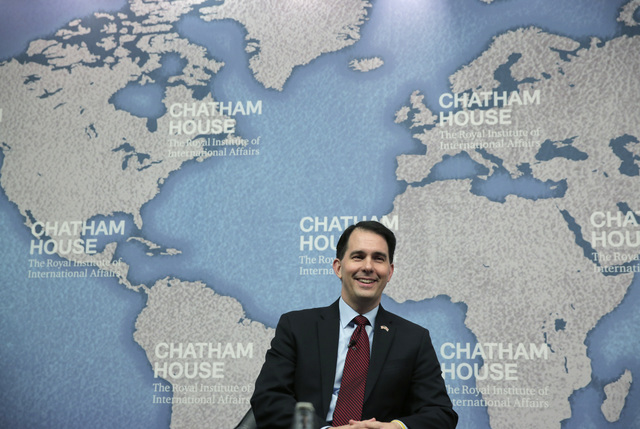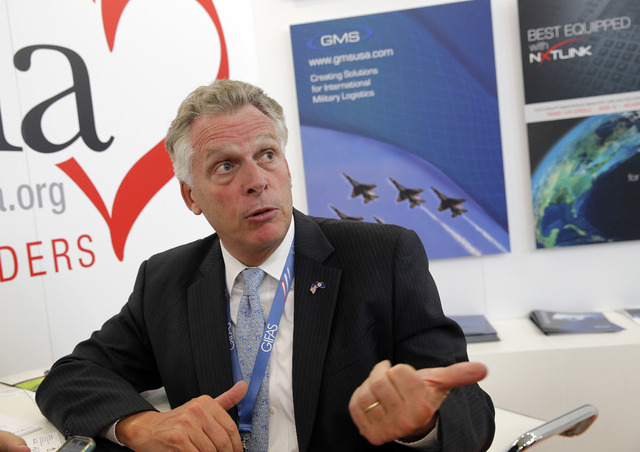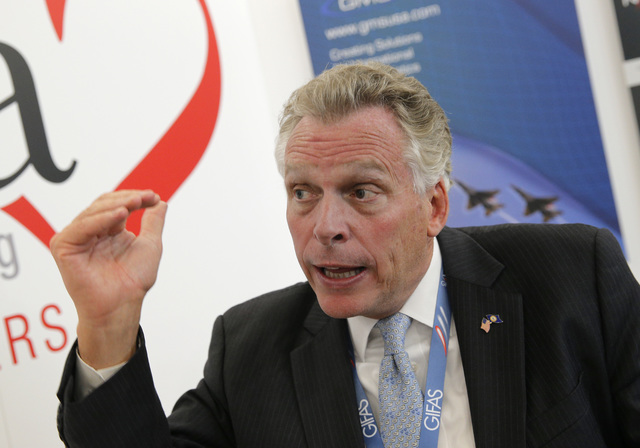Governors’ trade missions have uneven record of success
JEFFERSON CITY, Mo. (AP) — Governors across the country have been packing their bags for all-expenses-paid trade missions abroad, spending taxpayer dollars on costly trips that have an uneven track record of yielding any tangible benefits for their states.
Last week alone, governors of 10 states were jetting across Europe, many converging at an air show in Paris. Others traveled to Canada, South America and Asia. At the beginning of last week, more than a quarter of the nation’s governors were out of the country.
Since the start of 2014, governors have taken or scheduled more than 80 trips to 30 countries in their efforts to increase exports and entice foreign companies to expand in their states, according to a nationwide analysis of gubernatorial trade trips by The Associated Press.
The results are mixed, with some governors striking multimillion-dollar business deals and others achieving little to show for their travels.
The AP analysis found that the cost to taxpayers has topped $2 million for the airfare, lodging, meals and promotional expenses of governors and their entourages. But the total cost is probably much higher: The bills for some trips have yet to be tallied, and many expenses have been paid directly by businesses or nonprofit organizations, which are not required to disclose all their spending.
In some cases, businesses that help sponsor the trips also pay to send along top executives, gaining direct access to governors and key staffers who can play pivotal roles in awarding financial incentives to companies. That has raised concerns among some government watchdog groups about the cozy nature of corporate-financed travel and the secrecy of money passing through nonprofit economic-development groups.
Trade trips can also help raise the profile of potential presidential candidates. Republican governors Chris Christie of New Jersey, Bobby Jindal of Louisiana and Scott Walker of Wisconsin have all taken multiple foreign trips while building toward possible 2016 White House bids. Texas Republican Rick Perry and Maryland Democrat Martin O’Malley also traveled abroad as governors last year before their terms ended and they entered the presidential race.
Governors generally defend the trips, citing their potential to produce important international business deals.
“We’ve found them to be a huge benefit,” said Missouri Gov. Jay Nixon, who traveled to the International Paris Air Show last week and to Italy, Germany and Spain in March. “I wouldn’t go if it wasn’t good for the taxpayers.”
Nixon recently announced one result from his spring trip: Piva Group, an Italian maker of vinyl windows, plans to invest $6.5 million to open its first U.S. manufacturing facility in Missouri, employing up to 122 people. The company could get nearly $1 million in state incentives.
The state reported $11,100 in travel costs, mainly to subsidize business leaders who went along. But most costs were covered by the Hawthorn Foundation, a business-funded Missouri nonprofit that declined AP’s repeated requests to detail its expenses.
Overall, however, the trade trips have a hit-and-miss track record. Some examples:
— New Hampshire residents are still waiting for results from a trip Gov. Maggie Hassan took to Turkey a year ago. The trip cost taxpayers $15,000 and included more than 100 matchmaking meetings with businesses, yet no specific deals have been announced.
— Christie, Jindal and Walker all traveled to the United Kingdom earlier this year and, combined, have visited nearly a dozen countries since 2014. Their trips have been touted as ways to boost business, though there have been few immediate results. Taxpayers spent at least $93,000 on Jindal’s trips, mostly for security. Christie’s trips cost taxpayers nearly $124,000, including $9,600 for his photographer. Just one of Walker’s trips, to London, cost the state more than $138,000.
— Six months after Kansas Gov. Sam Brownback traveled to China with commerce and agriculture officials, Brownback spokeswoman Eileen Hawley said the “potential projects are still confidential.” The trip cost the state about $21,000.
— South Carolina Gov. Nikki Haley traveled to her parents’ native India in November, costing the state more than $56,000 for travel, lodging, meals and marketing and about $10,000 from a “special events fund” financed by businesses and economic-development groups. The state commerce department said the trip resulted in more than 30 “opportunities” its employees are pursuing, although no specific deals have been announced.
Haley had more success in March, when a secretive trip to Sweden was followed weeks later by an announcement that Volvo would build its first U.S. auto plant in South Carolina in exchange for more than $200 million in state incentives.
Governors often are quick to tout their trade missions when they pay off with new jobs or trade partners.
After Tennessee Gov. Bill Haslam took a weeklong trade trip to Japan and South Korea in June 2014, Bridgestone announced plans to build a $233 million headquarters in Nashville. That was followed by the Denso auto parts supplier announcing an $85 million Tennessee expansion and Nissan announcing a $160 million project for parts suppliers. The state Department of Economic and Community Development said it spent about $19,000 on the trip.
In some states, the costs remain unclear. Kentucky Gov. Steve Beshear has taken eight foreign trips since 2014 — the most of any governor — but his administration has not yet provided costs to the AP. And the Indiana Economic Development Foundation has not disclosed costs for any of the five foreign trade trips taken since last year by Gov. Mike Pence.
California has been more forthcoming: When Gov. Jerry Brown and 15 lawmakers went to Mexico City last summer, about 90 business owners, lobbyists and political operatives paid $5,000 a piece to go along. Brown used the trip to sign various nonbinding agreements with Mexican officials on trade, education and environmental cooperation.
Despite some successes, the degree to which such trips actually increase economic activity remains in dispute.
“The reason there’s no consensus is because it’s really hard to measure how much of any export is due to this trip,” said Andrew Cassey, an associate economics professor at Washington State University who analyzed more than 500 gubernatorial trade trips taken from 1997 through 2006.
It can take years to know whether the personal relationships forged on foreign trade trips pay off with increased business, he said.
Cassey found the most common destinations were countries to which states already were exporting relatively large amounts of goods.
Germany, the United Kingdom, Japan and China are the top destinations for governors, the AP analysis found. Mexico, Canada, France and Israel also are common targets.
Often, governors and business leaders will line up deals that can be finalized on foreign soil as evidence of the successful fruits of their trips.
For example, Florida Gov. Rick Scott announced at the Paris Air show that two aerospace companies were relocating a total of 80 employees from other states to Florida. While traveling to Brazil last week, Georgia Gov. Nathan Deal announced that the Brazilian information technology company Stefanini will add 400 jobs to its Atlanta office. And Virginia Gov. Terry McAuliffe announced multiple deals during a six-country European tour, including an expansion by a U.K.-based auto insurer that could add almost than 1,200 jobs in Virginia and a $200 million Virginia expansion by German grocer Lidl.
The trade trip is estimated to cost Virginia taxpayers more than $176,000. But McAuliffe, a former businessman, said such travel is crucial to attract foreign companies.
“To be honest with you, we wouldn’t have gotten these deals unless they can sit and look at me eyeball to eyeball,” McAuliffe told the AP at the Paris Air Show. “These trips are the way you close deals.”
———
Associated Press Writer Jamey Keaten in Paris and AP reporters in every U.S. state contributed to this report.





